First, thanks for reading my question. I wrote a program that
- detect moving objects in the scene (from a stationary camera)
- track them
- try to match them with static database and recognize them
in this picture you can see the results in a sample video, the program is working fine , it detects the red car recognize it and it is tracking the car::

note:orange dots shows where extra samples are acquired for dynamic database for future use.
Problem: to put it in a nutshell my method is to
- extract region of interests
- local feature detection[FAST feature detector]
- local feature extraction[SIFT descriptor extractor]
- descriptor matching [Brute force matching]
I have 3 database that each object is compared to. I want my program to be as fast as it can be, because it's meant to run on an embedded board (like Raspberry pi 2) but it's quiet slow and not real-time at this point , I pinpoint the time consuming line and it is the SIFT descriptor extractor i tried to use other extractor that usually works well with FAST detector like BRIEF or ORB extractor and they run much faster than SIFT instead they return poor results and matching rate decrease significantly, would you please help me to understand how can I use this combination FAST detector/ BRIEF or ORB extractor/ BF or FLANN match here are mentioned functions::
void Objects::calKeypointDiscriptor(Mat inputFrame,Mat &ROI,Rect RegionArea,vector<KeyPoint> &fastKey, Mat &briefDescriptors,bool display)
{
SurfFeatureDetector detectorSURF(300);
SiftFeatureDetector detectorSIFT(400);
FastFeatureDetector detectorFAST(30);
OrbFeatureDetector detectorORB (400);
SurfDescriptorExtractor extractorSURF;
SiftDescriptorExtractor extractorSIFT;
OrbDescriptorExtractor extractorORB;
BriefDescriptorExtractor extractorBRIEF;
FREAK extractorFREAK;
Mat regionTemp;
Mat frame=inputFrame;
regionTemp=frame(RegionArea);
ROI=regionTemp.clone();
detectorFAST.detect(regionTemp, fastKey);
extractorSIFT.compute(regionTemp, fastKey, briefDescriptors);
}
void Objects::matchDiscriptorFlann(Mat ROI,int distance,Point2i center,vector<KeyPoint>keypo,Mat descriptors,vector<Objects> objectVector,bool &matched,int vctorEnd,int &index)
{
BFMatcher matcherBF(NORM_L2);
FlannBasedMatcher matcherFLANN;
Mat img_matches;
for(int i=0; i<=vctorEnd; i++)
{
if (distance>0)
{
bool chk= euclideanDistance(objectVector[i]. center_obj,center)<distance;
}
else
{
bool chk=true;
}
vector< DMatch > good_matches;
vector<DMatch> matches;
if (descriptors.rows*descriptors.cols!=0&&objectVector[i].discriptor_obj.rows*objectVector[i].discriptor_obj.cols!=0)
{
matcherBF.match(descriptors,objectVector[i].discriptor_obj,matches);
double max_dist = 0;
double min_dist = 100;
for( int i = 0; i < descriptors.rows; i++ )
{
double dist = matches[i].distance;
if( dist < min_dist ) min_dist = dist;
if( dist > max_dist ) max_dist = dist;
}
for( int i = 0; i < descriptors.rows; i++ )
{
if( matches[i].distance <=2*min_dist )
{
good_matches.push_back( matches[i]);
}
}
if(good_matches.size()>2)
{
matched=true;
index=i;
}
}
}
}